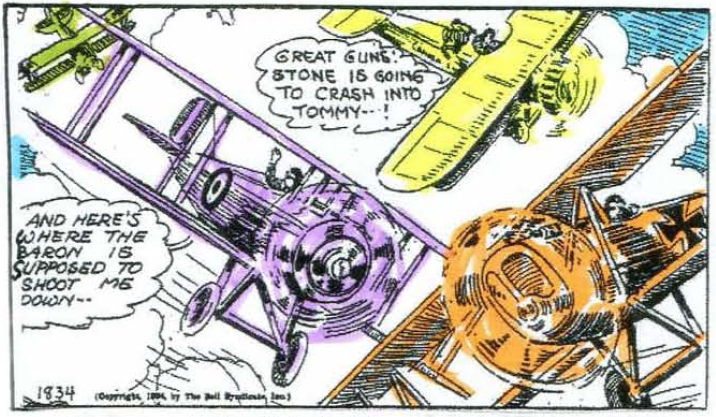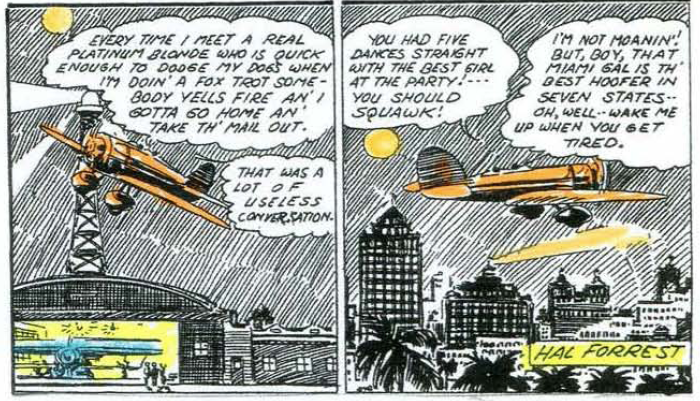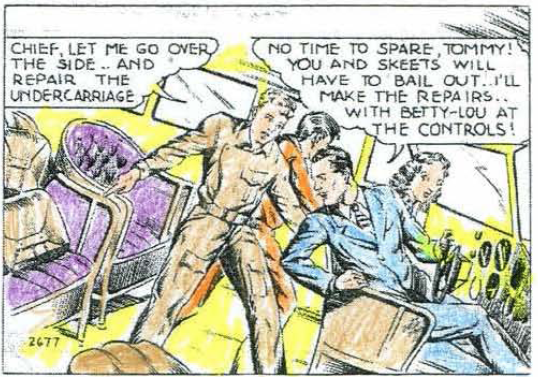|

This story was published in Radio Recall, the journal of the Metropolitan Washington Old-Time Radio Club, published six times per year.
Click here to return to the index of selected articles.
|
|
Early Air Adventures of Tailspin Tommy
by Karl Schadow, ©2013
(From Radio Recall, October 2013)
"All right, Skeeter," Tommy exclaimed to his
pal, "...let 'em have it!" There was a roar of
machine gun fire. Were these two gangsters
making a hit on a rival mob? No, indeed. This was
one of the exhilarating scenes highlighting a 1941
radio episode of the aviation thriller, Tailspin
Tommy. This article will provide an
introductory overview of Tailspin Tommy focusing
on his radio exploits.
The characters Tommy Tomkins (often
erroneously spelled as Tompkins), Clarence
"Skeeter" (or "Skeets") Milligan and Tommy's love
interest, Betty Lou Barnes first graced the comic
pages of the daily newspapers in April, 1928.
Created by Glenn Chaffin and Hal Forrest and
distributed via The Bell Syndicate, the strip is
often touted as the initial aviation venture though
it appeared a few months after the United Feature
Syndicate (UFS) Skylark (by Elmer Woggon &
Eddie Stinson).
 |
| Tommy expertly flew all kinds of aircraft including WWI biplanes for a movie being filmed at Three-Point in 1934. Original copyright 1934 Hal Forrest. |
Both of these followed Hal Forrest's self-syndicated,
short-lived Artie the Ace (ca.
1926-27). In 1933, Chaffin left Tailspin Tommy. In
1935 Forrest once again had a partner as
Reynold Brown contributed excellent artistry
throughout the remainder of the strip until it
ceased in 1942 (www.reynoldbrownart.com). The strip had been syndicated by
UFS from July, 1939 through its completion.
Tailspin Tommy benefited from the great
aviation boom of the late 1920s, resulting in a
Sunday comic page added in October, 1929. The
strip was adapted to the silver screen with a
Universal serial in 1934 starring Maurice Murphy
(Tommy), Noah Beery, Jr. (Skeeter), with Patricia
Farr as Betty Lou. The following year, another
Universal serial was released with Clark Williams
as Tommy.
Four feature films appeared in 1939 from
Monogram Pictures. During the 1930s and
1940s, Tailspin Tommy appeared in numerous
comic books, a dozen Big (Better) Little Books,
several Big Thrill Chewing Gum Premium
Booklets and two issues of a pulp magazine in
1936-37. More on Tailspin Tommy may be found
in the comics histories by Maurice Hom and Ron
Goulart, and at Steve Remington's aviation site
(www.collectair.com).
During its early years, radio was often scorned
by the fourth estate over issues from advertising
expenditures to news coverage. Thus one of
the initial radio adaptations of Tailspin Tommy was
a fascinating enterprise; the result of the
promotional campaign for the newspaper strip
which was to debut on Monday, June 24, 1929 in
the Pittsburgh Press.
The Press went all out in advertising its new
daily feature with a "Tailspin Tommy" aviation ball,
an aviation day at the local Bettis Field and at
3:00 pm on Thursday, June 20, 1929 a 30-minute
drama on KDKA. This production entitled,
"Tailspin Tommy Flys to Fame" was written and
directed by Marjorie Stewart, though blind since
childhood was a major contributor to the
excellence of Pittsburgh radio, having joined
KDKA in 1922 as one of the medium's earliest
critics.
Although a script has not been located of this
endeavor, the plot was culled by Miss Stewart
from a years-worth of adventures in the
newspaper. Tommy had grown up in Littleville,
Colorado as an auto mechanic so obsessed by
flying that all he talked about was aviation. Then
the locals later anointed him his nickname,
"Tailspin" (originally "Tail-Spin").
After assisting in the repair of a downed
mail plane, he was offered a job as an airplane
mechanic at the plane's firm, Three-Point Airlines
(with Paul Smith, President) which brought him to
its home base in Texas. There he got his friend
Skeeter a job as a fellow mechanic and met the
girl of his dreams, Betty Lou Barnes. All three
eventually became expert pilots which took them
on adventures from the routine mail routes,
thwarting gangsters, and dictators in foreign
countries.
There was much publicity in the Press afforded
the Pittsburgh broadcast including cast members
who were current students or recent graduates
from the Carnegie Tech Drama Department (now
Carnegie Mellon University Drama School)
including: Jack Woolley, R. Theodore Shaw,
Albert J. Carles, Donn Sonhoff, Ruth Aston, Ben
Avon with Frank Clegg providing sound patterns.
This contingent was complemented by two area
radio veterans, pianist Earl Truxell and Jack
Thompson, well-known humorist and dialectition.
Sponsored by the recently established Good
Will Federation, an association of local civic
groups and clubs whose executive secretary Mrs.
William Gardner and local radio executive David
Feigley spearheaded its radio activities, the
endeavor was also produced through the
auspices of the Aero Club of Pittsburgh. This
group of flight enthusiasts had been founded in
1909 to promote aviation in Western
Pennsylvania.
Thus, this local production of Tailspin Tommy lead the way for Smilin' Jack and Terry & the
Pirates among others who had begun on
the newspaper comic page and had flown via
etherwaves. To learn more about Tommy's fellow
aviators and aviatrixes, see the links at the end of
this article for works by Jack French, Maury Cagle
and Mike Gretz.
Though audio remains elusive of the KDKA
broadcast, fans of Tailspin Tommy have the
opportunity to enjoy two, 15-minute episodes
(available at www.otrrlibrary.org). These may be
part of any of three possible series which were
attempted in the 1930s. The Billboard (June 16,
1934) announced that Tailspin Tommy was being
auditioned that week for Scott's Emulsion and
slated for CBS through the N.W. Ayer agency.
The two episodes cited above appear to be
from a proposed daily series. The plots involve
two different stories, the first with Tommy and
Skeeter traveling via ocean liner to Carablanca
where they sojourn to a mysterious castle. At the
close of the episode, Tommy and Skeeter journey
to the microphone to say hello to all of their fans
and encourage them to request their own Tailspin
Tommy Flying Wings or Flying Cap. A Tailspin
Tommy Wings Badge is pictured in Hake's Guide,
however no radio program is mentioned.
 |
| Duty calls as Tommy and Skeeter often flew in two-seaters as in this adventure from 1932. Original copyright 1932 Glenn Chaffin & Hal Forrest. |
In the other episode, we join Tommy and
Skeeter in the air as they battle a fire in an oil well
which is owned by John Barnes (Betty Lou's
uncle). Although Tommy and Skeeter don't speak
directly to listeners in this adventure, they are
identified by announcer Wendell Niles as Maurice
Murphy and Noah Beery, Jr. The actress
portraying Betty Lou is not credited but could be Patrcia Farr. You may recall that this trio starred in
the first Universal serial in 1934. Was the radio
program an attempt to promote the movie? In
both episodes a Tailspin Tommy Flying Club and
CBS cue are included. A Club was a featured
alongside the Sunday Comics from ca.
1935-1938.
Though the scriptwriter of these episodes is
not credited and remains unknown, the author of a work dated July 1, 1937 entitled, "Tailspin
Tommy No. 1" is credited as Robert Lewis
Shayon. This recent discovery is the result of the
diligence of Laura Russo who unearthed this gem
in the collection of Mr. Shayon's papers housed at
the Howard Gotlieb Archival Research Center at
Boston University. Highly regarded as a writer/producer/director and critic in radio, Mr. Shayon
was a member of the Fanchon & Marco (F &
M) talent agency production staff in 1937. The
June 19, 1937 issue of The Billboard indicated
that Samuel Shayon of F & M had both the radio
and picture rights to Tailspin Tommy. Both
Shayon's had collaborated on other F & M radio
productions.
By 1938, the character was being handled by
West Coast freelance promoter, Sig Schlager. A
radio audition produced by American Radio
Features Syndicate (ARFS) was disclosed in the
August 15th issue of Broadcasting. This firm was
founded in the early 1930s by Frederick
Dahlquist. Interestingly, there is no mention of Sig
Schlager in this announcement. However, an ad
in the October 24, 1938 issue of Daily Variety indicates that radio and playrights are in
negotiation.
Incidentally, the main thrust of the ad was
the recent procurement of Paul Malvern
Productions as the firm to film the four Monogram
Pictures. Late in October, 1938, ARFS was
dissolved by Fred Dahlquist. Thus, the fate of this
and the other auditions remain to be elucidated.
Are those two 15-minute cliffhangers part of the
proposed 1934 CBS series?
Audio is also available (courtesy of Jack
French) of two, 30-minute episodes of another
CBS Tailspin Tommy series. Broadcast from the
KNX studios in Hollywood, each of the extant
episodes is a complete story. This series of
thirteen episodes commenced as a sustainer on
Friday, September 5, 1941 at 8:30 pm (PST) and
was heard over a regional network of West Coast
and Rocky Mountain stations.
As of October 5, 1941 , the program was
broadcast on Sunday afternoons at 4:30 pm
(PST) and continued into December. Though no
cast is credited in the two extant episodes,
publicity in the trade (and confirmed by this
author) indicated the following: Jack Arnold
(Tommy), Earl Hammond (Skeeter), with Dorothy
Scott as Betty Lou. Ted Bliss was the producer
with Bob Lemond as announcer.
The first of the extant episodes is the series
opener of September 5th, in which Tommy and
Skeeter rescue the rightful owner of a tungsten
mine unlawfully taken over by gangsters. The
other story is from the initial Sunday broadcast
(October 5th). There was much excitement and
danger (per opening paragraph) as Tommy,
Skeeter and Betty Lou attempt to solve the
murder of a stunt pilot during the filming of a movie at Three-Point.
 |
| A perilous situation from a 1936 escapade. From L-R: Tommy, Skeets and Paul Smith with Betty Lou at the controls. © 2013 Estate of Reynold Brown / Artists Rights Society (ARS), New York. |
Subsequent critique of this series will await the perusal of the remaining eleven scripts as
Patrick Kerwin (Library of Congress) and Fuller French (ARTS Library, Ft. Worth, Texas) have
updated this author on the holdings of these respective collections.
Author contact bluecar91@hotmail.com
Links to articles:
Jack French
www.otrsite.com/articles/artjf005.html
Maury Cagle
www.mwotrc.com/rr2006_02/intheair.htm
Mike Gretz
www.antiqueairfield.com/features/aviation_programs_in_the_golden_age_of_radio.html
|